In this paper, a comparison between meme cycles and joke cycles is carried out, using the tools of the General Theory of Verbal Humor and its analysis of joke cycles as consisting of intertextual and metatextual variants of the original joke. It is shown that the same tools can be applied to joke cycles and to meme cycles. The methodology is applied to a meme cycle called Cheryl’s She Shed. The analysis shows that the users start from the original video featuring Cheryl’s shed on fire, but soon the process of meme creation (memeiosis) is activated and users start generating all sorts of memes remixing various aspects of the original video and adding other ideas, such as a conspiracy theory about the source of the fire. Eventually, the drift is broad enough that intertextual memes start to appear which require a reference to another text to function, and eventually meta-memes also appear (memes that fail to deliver a meme and are funny because of the violation of expectations). In conclusion, speakers use memes to express their concerns and interests. Meme cycles are very similar to joke cycles, except for the speed of diffusion, a shorter life span, and an increased ease of manipulation of images and text.
Salvatore Attardo — PhD in Linguistics;
salvatore.attardo@tamuc.edu
Texas A&M University-Commerce,
P.O. Box 3011, Commerce, TX, 75429, USA
Salvatore Attardo — PhD in Linguistics;
salvatore.attardo@tamuc.edu
Texas A&M University-Commerce,
P.O. Box 3011, Commerce, TX, 75429, USA
Attardo, S. (2020). Memes, memeiosis, and memetic drift: Cheryl’s Chichier She Shed. Media Linguistics, 7 (2), 146–168.
URL: https://medialing.ru/memes-memeiosis-and-memetic-drift-cheryls-chichier-she-shed/ (accessed: 19.04.2024)
Attardo, S. (2020). Memes, memeiosis, and memetic drift: Cheryl’s Chichier She Shed. Медиалингвистика, 7 (2), 146–168.
URL: https://medialing.ru/memes-memeiosis-and-memetic-drift-cheryls-chichier-she-shed/ (дата обращения: 19.04.2024)
UDC 81.27
Introduction
In this paper, I will analyze a meme cycle, and namely the Cheryl’s she shed meme. In order to do so, I will introduce some terms about memes and the production of memes (memeiosis) and the concept of joke cycle, because the analysis is based on these ideas. In particular, I will show that there are significant similarities between joke cycles and meme cycles, and in particular that the connections between memes can be accounted for in the same way that connections between jokes are accounted for. In the last section of the paper, I will briefly touch upon the differences between the two.
A short history of memes
The word “meme” was coined in Dawkins [Dawkins 1976] as a self-replicating cultural analog of genes. Memes are to culture what genes are to DNA. The idea became successful after it was adopted by Dennett [Dennett 1991; 1995] and Blackmore’s successful exposition of it in The Meme Machine [Blackmore 1999]. Blackmore defines memes as units of imitation. This deserves a little explanation. Dawkins distinguishes between replicators (copying mechanism) and the entities through which they interact with the environment (vehicles, or interactors, in Dawkins and Blackmore’s terminologies, respectively). Thu DNA is the replicator whereas humans are its vehicle/interactor. The key concept is the copying/replicating, not the interactor. A gene may conceivably shift vehicles, but if a gene changes it no longer is the same gene. Thus in a sense, memes are a different version of genes, except they replicate in the cultural milieu, rather than in the gene pool. Wearing clothes or shoes with a given logo or color is a meme because it leads human vehicles to copy it (replicate it). Needless to say, criticisms of memetics ranged from the fact that is was a pseudoscientific concept [Benitez Bribiesca 2001] to the observation that it neglects the agency of the humans who choose to do the replicating [Jenkins et al. 2013].
The success of memetics waned in the early 2000s and soon the term shifted meaning and through semantic narrowing came to refer to an image, usually with a caption, distributed through social media. In this sense they are sometimes referred to as “internetmemes.” Since there seems to be little risk of confusion I have preferred the shorter “meme” assuming that context will disambiguate.
Börzsei [Börzsei 2013] in an attempt to date the first academic discussion of memes states that
The first “academically rigorous” definition for [memes] was proposed by Patrick Davison in 2009 in his essay The Language of Internet Memes:
An Internet meme is a piece of culture, typically a joke, which gains influence through online transmission [Börzsei 2013: 122] (my emphasis, SA)
However, the following definition by Burgess [Burgess 2008] seems to both predate and be preferable to Davison’s definition:
an internet ‘meme’ is a faddish joke or practice (like a humorous way of captioning cat pictures) that becomes widely imitated. In this popular understanding, internet `memes’ do appear to spread and replicate ‘virally’ — that is, they appear to spread and mutate via distributed networks in ways that the original producers cannot determine and control [Burgess 2008: 101].
Burgess insists that the idea of “meme” and “virality” are metaphorical, i. e., memes are not really genes and do not behave as viruses, except metaphorically. Furthermore, the definition of memes as “fads” is apt, since their life-span is much shorter than joke cycles. This is why, incidentally, I insist that the equation gene = meme is metaphorical: in genetics once a gene evolves, if it is successful, it survives and is passed on. In memetics, if a meme is successful it survives and is passed on. However, and here the metaphor breaks down, after a while it stops being successful and becomes unfashionable and is no longer passed on. It would be as if an organism developed eyes and then after a while decided to devolve abandoning vision, with the environment unchanged. It may not be impossible to model this dynamics (e.g. [Matsubara et al. 2012]), but it is outside of the concerns of this paper.
Furthermore, what is probably the first serious scholarly discussion of memes, although she does not use the term “meme,” comes from Giselinde Kuipers, a renowned humor scholar and sociologist [Kuipers 2005] who states that
The events of September 11 (…) gave an impetus to a new genre: cut-and-paste Internet jokes that were shared and spread around the world through e‑mail, newsgroups, and Web-sites. (p. 70)
The remixing aspect of memes is clearly captured (“cut-and-paste”) as is the virality (“spread around the world”); likewise, Kuipers is clear that memes are a genre of jokes and in fact compares 9/11 memes to disaster joke cycles. It should be noted that Facebook was not widely available until 2004 and Youtube was not available until 2005, so Kuipers is correct about the early diffusion routes of memes.
Davison [Davison 2009] identifies three components to a meme:
1. The manifestation i. e., “its observable, external phenomena,” for example an image of a cat.
2. The behavior i. e., “the action taken by an individual in service of the meme” for example “photographing a cat and manipulating that photograph with software”
3. The ideal, i. e., the concept conveyed by the meme: “the ideal is something like ‘cats are funny’.” (p. 123)
Börzsei [Börzsei 2013] provides a history of the diffusion of memes on the internet. It is unquestionable that two factors made memes possible: the virtually ubiquitous availability of a no-cost virtually instantaneous means of mass diffusion and, second, the availability of cheap and eventually free image editing tools: Photoshop and other image editing software afforded the capacity to remix visual media but required some image editing skills; eventually the same capability was afforded by the availability of free meme generators which allow anyone, regardless of image editing skills, to produce professionallooking memes. We will return to the matter of ease of production.
One final consideration, more or less implicit in all the definitions that we have examined: memes are very often humorous, but in Dawkins original definition, they are more frequently serious. There is nothing inherently funny to memes. We could distinguish between humorous and serious memes, but there seems little likelihood of confusion. In what follows I will use the term meme as a shorthand for humorous internet meme and in the few occasions where I present a non-humorous meme, I will assume that the context is clear enough to disambiguate.
Collections of memes
Shifman [Shifman 2014a: 7–8] defines memes as
an internet meme as a group of digital items sharing common characteristics of content, form, and/or stance; (b) that were created with awareness of each other; and © were circulated, imitated, and transformed via the internet by many users. [emphasis in the original]
as she herself emphasizes, this is departure from the Dawkins/Blackmore definition because it considers memes not as single units, but as “groups of content units” [Shifman 2014b: 341] since as she points out, in the era of the internet one can easily assess literally hundreds of variants of memes. Segev et al. [Segev et al. 2015] use the term meme “families.” While it is unquestionably true that the internet, search engines, and aggregation sites, have changed the availability of collections of memes, I think that, at least in most cases, for example Rickrolling, memes are experienced individually (one by one) and acquire the group dynamics described by Shifman only at a different level of engagement (i. e., when the person actively seeks out the meme). I think it is preferable to distinguish two levels: passive fruition, in which a user may encounter a given instance of a meme by itself, and an active level in which the user seeks out the meme and is fully aware of the existence of a cycle of memes. The latter mode of engagement already involves some degree of metapragmatic awareness. In passing, I might note that my decision to focus on individual memes is faithful to the genetic metaphor of Dawkins, as Davison explains “the basic units of genetics are not species, families, or even individuals but rather single genes—unique strands of DNA” [Davison 2009: 121].
On the matter of the shared characteristics, Shifman also observes that
While one might expect that in the absence of formal gatekeeping people would create an endless array of meme types, in reality, participants tend to mold their memetic contributions according to a surprisingly small number of formulations […]. These include, for instance, Rage Comics and LolCats, re-cut trailers and lip-dubs. The apparent rigidity of users who work within a few generic boxes may in fact have an important social function: following shared pathways for meme production is vital for creating a sense of community in a fragmented world [Shifman 2014b: 342].
Shifman’s point is well taken, but we may suggest another, complementary notion: by fitting within a meme genre, the would-be meme maker is facilitated in his/her task, especially if they choose to use a meme generator web site, a point already made in [Börzsei 2013]. In other words, genres make both understanding and creating memes easier. If we are exposed to a LOL cat meme we know what to expect. If we use a meme generator, the template forces us to input text in a given position, etc. Another reason is suggested by Shifman herself [Shifman 2014a: 173], i. e., that using appropriately a given meme demonstrates that one understands it, i. e., is an in-group marker.
Connections among memes
As we saw, the very definition of meme, at least for Shifman, but generally speaking the idea that meme families or genres exist, is based on the awareness of the fact that memes display connections among them.
This has been handled in different ways in the literature. For example, Burgess [Burgess 2008] speaks of “textual hooks or key signifiers,” which, through “repetition” become “recognizable” (pp. 5–6) and thus act as connectors between otherwise different iterations of memes. According to Lewis, “particular elements of the meme always appear in remixes while others are replaceable and unimportant to the meme.” These are classified as fixed and fungible elements; the latter are replaceable and invite remixing [Lewis 2012].
Segev et al. [Segev et al. 2015: 419] maintain “that internet-based meme families are bound by two forces: specific quiddities and general attributes that derive from the context of meme culture.” Quiddities may be visual or verbal (p. 419) and abstract or concrete (p. 420). An enlightening example of “basic quiddities” is provided: “an ice bucket being poured on a person’s head and naming three other people to be challenged” (p. 419). Further examples of quiddities are provided, from which it is clear that the authors mean formulaic expressions, such as the phrasal template (“I don’t always X, but when I do, I Y”) of the The Most Interesting Man in the World meme, and visual elements, such as the spraying cop of the meme Casually Pepper Spray Everything Cop (https://knowyourmeme.com/memes/casually-pepper-spray-everything-cop) or recreating the scenery of the Leave Britney Alone meme, i. e., the speaker has a cloth blocking out the background immediately behind him/her. Segev at al. [Segev et al. 2015] conclude that “visual quiddities tend to be more immutable and concrete while textual quiddities tend to be changeable” (p. 420), which is reasonable but not an absolute truth in the age of Photoshop and deep fakes.
The problem with the idea of quiddities is that, as Burgess [Burgess 2008: 5] noted, they “cannot be identified in advance (even, or especially, by their authors) but only after the fact, when they have become prominent via being selected a number of times for repetition.” Therefore using the definition of quiddity or key signifier yields that memes are connected by those elements that connect them. This is obviously an unsatisfactory definition. Indeed, Segev et al. [Segev et al. 2015] note that “existing research has not strived to define or categorize internet memes’ quiddities as such.” (p. 419)
I will suggest that rather than generic quiddities, memes, like jokes, enter in three kinds of relationships: 1) the type of relationships that make up jokes and are described in the General Theory of Verbal Humor (GTVH; to be described in the next section), i. e., the textual knowledge resources that make up the text of the joke/meme, with the caveat that “text” needs to be understood in a broad semiotic sense, including images and other means of signification, e.g., video, music, etc. 2) Intertextual relationships, in which jokes/memes are fully understandable only via a reference to another text: in the case of memes, the founder meme [Shifman 2014a: 59], in the case of jokes, the original joke. 3) Metatextual relationships, in which the joke/meme refers indirectly to its textual nature and “plays” on it. These ideas will be developed below, after we examine their occurrence in joke cycles.
Joke cycles
The GTVH [Raskin 1985; Attardo, Raskin 1991; Attardo 2001; 2017a], originally a theory of jokes, was later developed to include also visual humor and texts much more complex and different than jokes, such as novels and conversations. The GTVH specifies that a humorous text is produced out of the information originating from of six Knowledge Resources. They are 1) the script opposition, the basic incongruity of the joke; 2) the logical mechanism, i. e., the resolution of the incongruity; 3) the situation, or the background information on the settings of the joke; 4) the target, or the butt of the joke, the person or entity being mocked; 5) the narrative strategy, i. e., the way the text is organized, such as a narrative, a question and answer format, riddle, etc., and finally 6) the language, understood in a broad semiotic sense as the signifier of the text (word choices, formulaic expressions, style, visual elements, etc.). Of these resources, the logical mechanism and the target are optional, as evidenced by nonsense and non-tendentious (non-aggressive) humor, respectively. The resources form a hierarchy which embodies an important aspect of the GTVH, i. e., the observation that the perceived differences of two jokes increases as they differ in the earlier resources, so that two jokes that differ in script opposition are perceived as much more different than two jokes that differ in language. In other words, the GTVH comes with a built-in metric of similarity.
A joke cycle is a set of jokes (usually canned jokes) that is related, mostly thematically, but usually also including some formal/textual similarity; for example, in the light bulb joke cycle the Question and Answer narrative strategy and the linguistic choices of “How many X does it take to change a lightbulb?” Hempelmann [Hempelmann 2003] has shown that the connections of joke cycles are mostly at the surface levels of the knowledge resources of the GTVH, i. e., mostly target (e.g., Belgian jokes, or jokes about Foolstowns), situation (e.g., a guy walks into a bar), or language (puns, or spoonerisms) [Attardo 2001: 68].
In [Attardo 2001: 70–75] I reconstructed the history of the light bulb joke cycle. Folklorists traced its origins to sometime before 1969, and by 1979 they report it was a national craze, having spread to the entire United States. By the 1980s, there were literally thousands of variants. The original joke ran as follows:
(а) How many Polacks does it take to screw in a light bulb? Five—one to hold the bulb and four to turn the ceiling (chair). [Dundes 1987: 143]
The variants that were developed took the following form:
(b) How many Californians does it take to screw in a light bulb? Ten. One to screw it in and nine others to share the experience.
(с) How many surrealists does it take to screw in a light bulb? Two. One to hold the giraffe, and the other to fill the bathtub with brightly colored machine tools.
(d) How many surrealists does it take to screw in a light bulb? Fish!
(e) How many Feminists does it take to screw in a light bulb? That’s not funny!!!
I distinguished parodic, intertextual jokes, such as (b) ad © which take the original joke (a) and vary the target and the logical mechanism by modifying the explanation of the unexpected, incongruous number of people doing the changing of the light bulb in a way that incorporates stereotypical information about the targeted group, and meta-jokes, which involve a metatextual failure to deliver a properly formed light bulb joke and then resolve the incongruity once more according to stereotype, as in examples © and (d). Unstated, but obvious, was the assumption that parodic jokes were even more different than jokes that differed by a knowledge resource, and that meta-jokes were the most different.
The above exposition of the GTVH is obviously very schematic and does not hope to be a full presentation, for which see the sources quoted above, but it puts us in the position of being able to compare joke cycles and meme cycles.
Comparisons between joke cycles and meme cycles
The idea of comparing memes to joke cycles is not new, see for example Meier & Medjesky [Meier, Medjesky 2018], who analyze the “that’s what she said” joke cycle. They however, mistakenly attribute the term to Boskin [Boskin 1997] whereas the term “joke cycles” has been in use at least since Abrahams [Abrahams 1961], which seems to be the first scholarly use of the term. Abrahams uses it interchangeably with “joke series.” However, he did not originate the term. In Abrahams references figures Sutton-Smith [Sutton-Smith 1960] who uses exclusively “joke series” but quotes Walker [Walker 1958] which uses “joke cycle.” Tsakona [Tsakona 2020] also compares joke cycles and memes, however she broadens the definition of joke cycle by including any joke/meme about given topic (the Timisoara diverted flight incident analyzed in her paper). In fact, she argues that memes “replace” oral jokes. Tsakona invokes intertextuality in the interpretation of memes: “interpreting a text presupposes the recognition and understanding of implicit or explicit intertextual references,” in this following my own work on intertextuality in joke cycles [Attardo 2001]. However, Tsakona significantly broadens the scope of the connection between humor and intertextuality to include the following:
- Online jokes recontextualize news reports on specific events that are announced through the media.
- Online jokes recontextualize other pre–existing texts that initially seem irrelevant to the main events referred to, but become relevant during the process of humor creation.
- Online jokes are subsequently cast in different forms, thus becoming a different genre. The practice of “redoing” or recreating digital texts by other means is particularly common among social media users and significantly contributes to the online spreading of cultural artefacts such as memes [Shifman 2014b; Laineste, Voolaid 2017; Tsakona 2020].
Tsakona [Tsakona 2020] concludes that new joke cycles last less that old ones (i. e., they age out of relevance faster).
We also take as axiomatic Shifman’s [Shifman 2014a] point that internet users both share static texts (virals) and create (remix) content (memes). On virals and remixes, see [Knobel, Lankshear 2008]. We are particularly interested in the creative aspect of the exchange (i. e., the creation if new memes, from recycled material) and will not deal with the sharing, except in passing. Virals and memes lie on a continuum ranging from the pure forwarding or reposting on an image/text without altering its format in any way, to the creation of a new meme [Shifman 2014b] and [Laineste, Voolaid 2017].
Jokes have always been known to “travel’’ far and wide, as they were easily translated and adapted to other cultures/countries, as do memes [Shifman 2014a: 155–170; Shifman, Thelwall 2009]. The work of Christie Davies is to a large extent dedicated to explicating and describing the fact that many of the same jokes occur across cultures and languages (e.g. [Davies 1990]). However, the life span of a joke cycle was significantly longer. For example, Sutton-Smith [Sutton-Smith 1960] and Boskin [Boskin 1997] reports that the cruel jokes (“Mommy, why is daddy so pale?” “Shut up and keep digging.”) or the elephant jokes (“How does an elephant hide in a cherry tree? It paints its toenails red.”) span decades. In contrast, Shifman and Thelwall document the spread of a meme globally in roughly a decade. We will consider the acceleration of the time span of joke/meme cycles in more detail below.
The alliterative arsonist
In this paper, I examine a meme cycle (or family) and specifically the cycle of Cheryl’s She Shed as a case study of sorts. I will focus on the mock “conspiracy theory” that claims that Cheryl’s she shed was burned down by her husband before addressing the relationships among the memes in the cycle.
The meme cycle originates from a successful television advert for an insurance company (State Farm). The commercial aired in March 2018 and went viral, having been broadcast 33,000 times (as of late September 2019) and having received more that 1.3 million views on You Tube (as of October 2019). Thus, as per Shifman [Shifman 2014a: 59], this is clearly a founder-based meme; we can identify with certainty its source, unlike for example, the “that’s what she said” meme, which as Meier & Medjesky [Meier, Medjesky 2018] point out, may originate from a TV sketch or a previous joke cycle “as the actress said to the bishop.” Furthermore, unlike the memes in [Laineste, Voolaid 2017], the joke cycle of Cheryl’s She Shed is culturally homogeneous (having developed in a US culture and being restricted to US topics). This obviously simplifies the analysis.
I collected the data on which this study is based with a series of searches on Google, Reddit, and Youtube, using keywords such as “Cheryl she shed,” “She shed conspiracy theory,” “State Farm She-shed commercial,” “she shed meme,” etc. I also used the spelling Sheryl, which appears in some of the memes. Since the results of the searches yielded millions of hits, I narrowed them down by restricting the search to images.
The advertisement from State Farm can be found on you-tube, at the following link: https://www.ispot.tv/ad/oOxK/state-farm-she-shed
It shows a typical suburban black couple. The wife (Cheryl) is on the phone with an insurance adjustor and says, “It finally happened, somebody burned down my she shed.” The husband who is standing next to her says: “Nobody burned down your she shed, Sheryl.” He has a dejected or resigned look and barely moves his mouth to speak, showing no affect. The next shot shows the characters from the back as they look upon the burning garden shed. The husband then says: “The shed was struck by lightning,” again without any affect. The agent then reassures Cheryl that her shed is covered by State Farm. Cheryl then says: “Did you hear that, Victor? I am getting a chichier she shed.” The next shot shows a chandelier falling from the burning ceiling of the shed. Victor is then seen saying “Chichier?” with a look of anguish. We can also see that he is holding a watering hose. Cheryl replies “uhuh.” and he respond by saying “That’s wonderful news” once more without affect. Cheryl turns to look at him, presumably having noticed his lack of affect. The final shot shows firemen beginning to subdue the flames. The video is framed at the beginning and end by advertising information about the State Farm.
The conspiracy theory parody
Soon there emerged a conspiracy theory blaming Victor, the emotionally stunted husband, for the arson. The main clues for the husband’s guilt were: 1) the fact that Cheryl seems to allude at previous attempts at burning the shed; 2) The ineffective use of a watering hose at a distance from the shed; 3) The lack of affect at the fire and the tone of voice when Cheryl announces the future reconstruction of the shed. 4) There is no trace of a lightning storm in the video. There is no rain visible nor thunder audible.
In the Youtube page there were 1629 comments, as of October 29, 2019. In the first few comments there are several who suggest that Victor burned down the shed. For example: “The husband did it!! We now know who burnt down Cheryl’s she shed!!” Another user says: “I call BS! I mean look at that sky! What lightning? He suspiciously holds the garden hose while making no attempt to get the fire wet before the firemen come.” Another includes emojis: “Lol [emoji tears of laughter] looks like hubby did it [double emoji of tears of laughter] standing there there [sic] with water hose and the shed still burning to the ground [double emoji of tears of laughter][emoji of index finger pointing upward].
Another user elaborates on the husband’s motivation for burning the shed: “I love the husband’s defeated tone. It’s like this isn’t the first or the last time with her. They probably bought the house together and decided to share the space evenly, but after awhile she took more and more until all he was left with was the shed. And then she took that.” One could multiply the examples, pointing at the husband and his guilt. However, not all conspiracy theories point to Victor. Others accuse Cheryl herself. This July 29, 2019 blog post lists four conspiracy theories, which include Victor, Cheryl herself, hate crimes, and an act of god (http://internetisinamerica.blogspot.com/2019/07/four-conspiracy-theories-concerning.html).
I suggest that the She-shed conspiracy is a parody of serious conspiracy theories (such as the moon landing denial, or the claim that the 9/11 bombing were “an inside job”, etc.). Essentially, a way to mockingly adopt a conspiracy theorist stance in what is clearly a) fictional and b) a trivial matter.
Where does the humor of the original video come from? The first script opposition [Raskin 1985] can be found in that garden sheds are normally bare bones, efficient structures for the purpose of storage of garden tools, or possibly for potting. The presence of the chandelier, tables, and armchairs (visible around 0.16 seconds in the video) tells us that the shed is indeed chichi (a colloquial term, derived from French chichi, meaning “unnecessary complication, useless frills” borrowed in English at the beginning of the 20th century, with the meaning of elaborate, elegant, probably by conflation with chic). The second opposition lies in the alliterative pattern of some of the lines, in particular “I am getting a chichier she shed” which produces a distinctly unlikely statistically repetition of the phoneme /∫/ which occurs in the onset of four consecutive syllables. The third opposition is easily derived from the description of the inappropriate affect and intonation of the husband. It is possible that the reader achieves also a further opposition between HUSBAND and ARSONIST, but the text can be appreciated as humorous without it, so it is not strictly necessary. Because we have more than one script opposition, this is a case of hyperdetermined humor [Attardo 1994: 261].
At this point, we have shown that the commercial achieved virality (> 1.3 million views) and that it generated a significant number of discussions or comments accusing Victor, Cheryl’s husband, of being the culprit of the arson. However, [Shifman 2014a] distinguishes between virality (sharing, retweeting, etc.) and memeiosis [Mitzel 2020; Shifman 2014a] does not use the term herself). Memeiosis is the process of producing new memes, hence it is a more active form of engagement with the meme. Memeiosis can consist of repackaging or imitation [Shifman 2014a: 19–20]. Imitation can be parodic or not. In our case, there have been no imitations of the meme that have gained significant distribution, at the time of writing. Conversely, the Cheryl’s She Shed meme invited a significant quantity of remixing (i. e., reproducing part of the original meme in different context or altering the meme) one of the two forms of repackaging. The other form of imitation, in which fans recreate a meme, seems also to be absent from the corpus.
Summing up, memeoisis can take the forms in figure 1:
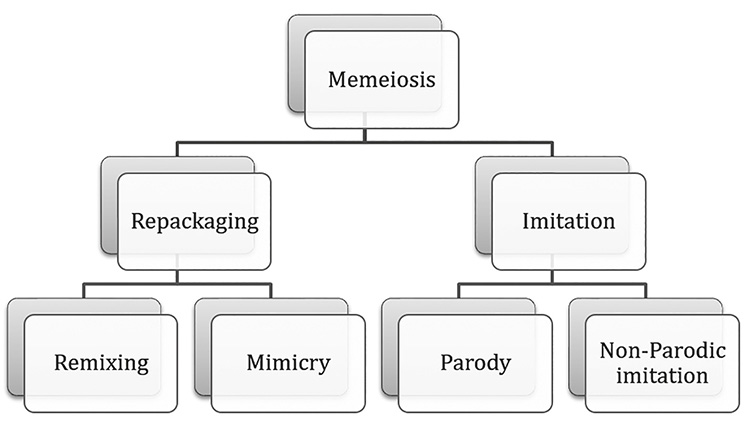
Not all memes followed the conspiracy theory, however. The following is a sampling of other memes.
Remixes of the founder meme
A common meme was to accuse Cheryl herself of burning the shed, either to collect insurance money, or because she ran a meth lab in it, as in figure 2 below.

https://www.instarix.org/media/2102678826772696124
Another theme was Cheryl’s revenge on Victor, as in figure 3.
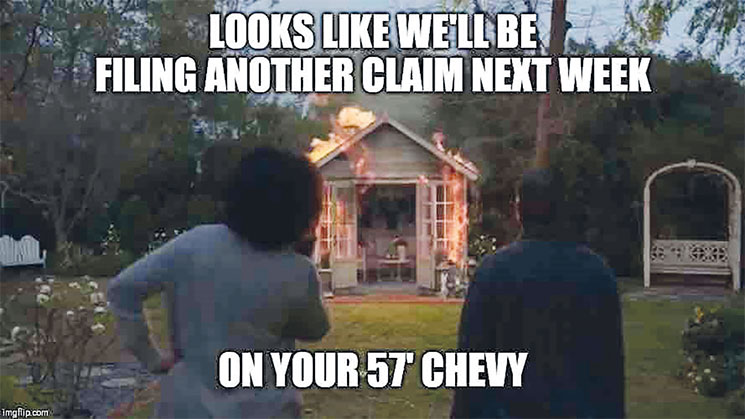
Other memes take a political turn. So, we get an anti-Democratic meme, as in figure 4.

And an anti-Republican meme, in figure 5.
Here the user produced the caption in the text of the tweet and reproduced the still from the video used in the memes. I have reproduced two comments, produced on the same day that the tweet was posted, by other users, one riffing off (mode adopt-
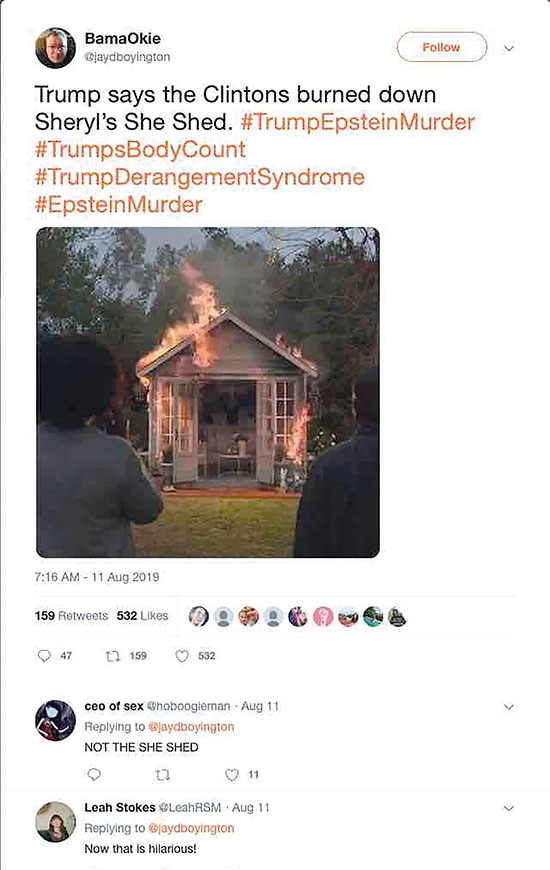
ing) the meme by bemoaning in all caps (hence, in internet-parlance shouting) “not the she shed” and the other supporting the humor [Hay 2001] by commenting “That’s hilarious!” Note in passing the alternative spellings of the name Cheryl/Sheryl, which are homophones.
The readers were quite sensitive to the alliterative aspect of the text, best captured by the following meme, in figure 6 which plays it up, reaching tongue twister levels:

Other variants show bare-chested hunky firemen with the caption “and this is why Cheryl burned down her she shed” implying that she did burn the shed so as to be able to meet or ogle the good-looking firemen. An example of this thread is reproduced below in figure 7.
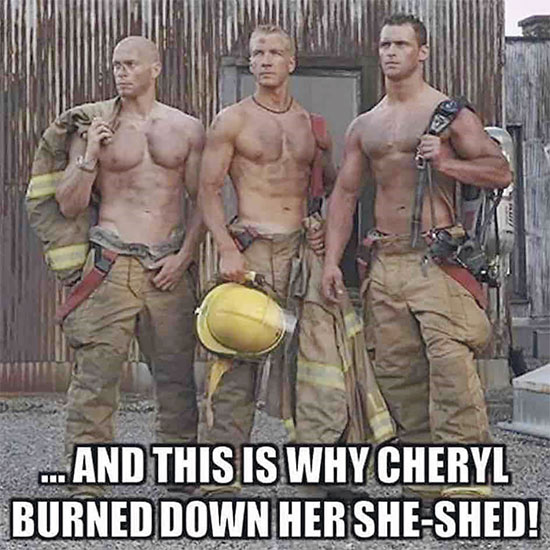
https://www.instazu.com/media/2132289081246080581
The last example assumes that the reader is already familiar with who Cheryl is and what happened to the shed.
Intertextual memes
Let us know consider more Cheryl’s She Shed memes. The first one, figure 8, is a mashup between Cheryl’s shed situation and Quentin Tarantino’s Pulp Fiction (the character of Jules Winnfield, played by Samuel L. Jackson). In the Pulp Fiction scene Winnfield objects to the repetition of the word “what.” Note in passing the error in the Cheryl caption “she-er” should have been “sheshe-er” (adopting the local spelling).
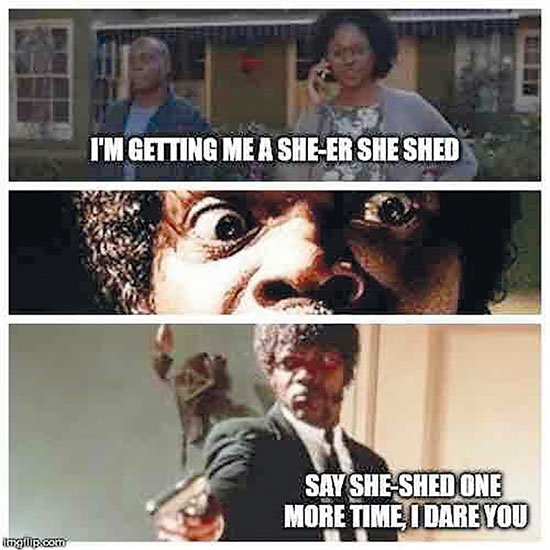
We find a Star Wars version, figure 9, in which Darth Vader and Emperor Palpatine have been photoshopped in place of Cheryl and Victor and an extra pun (Sith shed vs. she shed) has been added:
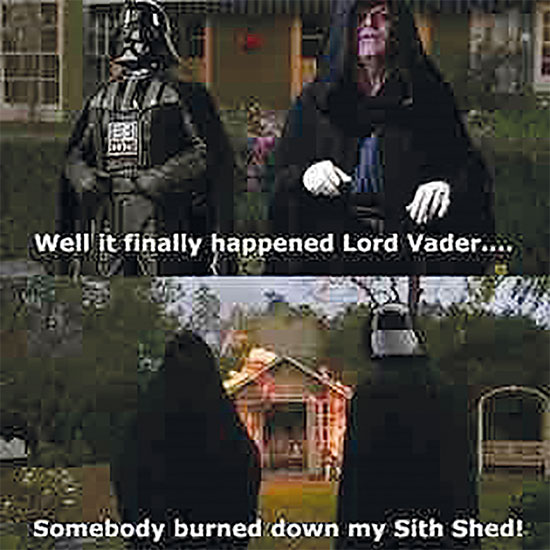
https://zoopps.com/media/2142428438634595313/B27b1BZgoPx
And a Sean Connery mashup, figure 10, in which the She Shed meme is blended with the Sean Connery pronunciation meme and the That’s What She Said meme, mocking his accent:
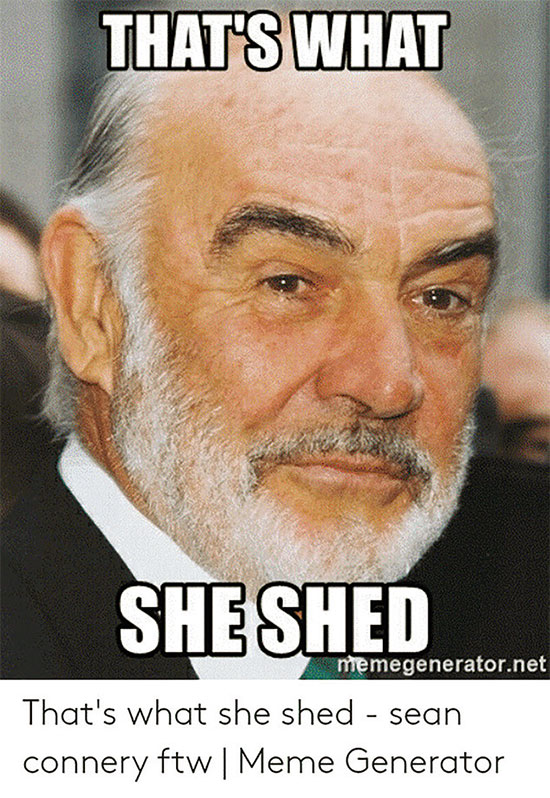
All these memes classified as intertextual share that they are incomprehensible without the external reference to another preexisting text, which is presupposed known.
Another example is the following, which includes a reference to rapper Tekashi 6ix-9nine (Daniel Hernandez) testimony (September 17, 2019) in a federal case against two former associates. This was perceived as “snitching.” We then get a mashup with the Cheryl’s She Shed meme, yielding the meme in figure 11 below:

Meta-memes
A meta-meme is to a meme what a meta-joke is to a joke. Much like in a meta joke the deliberate failure to deliver a joke when one is expected is itself a joke, as in the celebrated “Why did the chicken cross the road? To get to the other side” joke, thus the failure to deliver a meme, when one is expected is a meta-meme. The form taken by most meta-memes is that of presenting most of the visual or textual aspects of the meme but then delivering in fact another meme.
An example of meta-meme is found in figure 12 below:
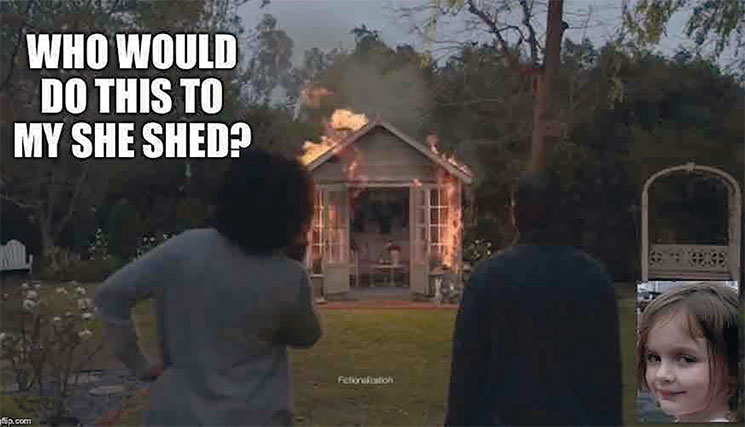
The meme in figure 13 requires knowledge of another series of memes, the Disaster Girl meme (https://knowyourmeme.com/memes/disaster-girl). The original Disaster Girl meme is reproduced below, in figure 13.
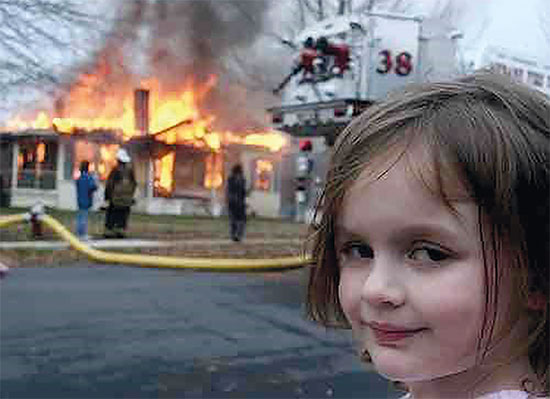
As can be seen, this mashup between two memes requires knowledge of both memes and under the guise of delivering a Cheryl’s she shed meme, in fact delivers a Disaster Girl meme. This makes is a meta-meme, under the definition provided above. As we anticipated, this is a level of engagement with the memes that circulate in a community that is qualitatively different from the simple appreciation or remixing of a meme, as it requires (implicit) meta-awareness of the nature of the text/meme.
Memetic drift
While the first iterations of the variations on a meme are relatively close to the meme itself, in due time memes that are fairly distant from the original emerge. We may label this “memetic drift.” In particular I propose that at a very high level of abstraction memetic drift takes generally speaking the form:
meme > virality > memeiosis (intertextual) > memeiosis (meta-textual).
It should be noted that by meta-meme, we mean something different than Lasn [Lasn 1999] and Allen [Allen 2003], as discussed in Buchel [Buchel 2012: 55].
Allen talks about a “Meme warfare” which “involves countering commercial images or ideas with a “metameme,” a meme that both repositions a corporate meme and invokes a larger critique of corporate culture. One of the metamemes identified by Lasn [Lasn 1999: 124] is “True Cost,” which calls attention to the ecological and human costs of a product beyond its sale price.” [Allen 2003: 21]
The most common way for memeiosis to enter the meta-textual domain is to reference another meme within the meme. For example, the version of the Snakes on a plane meme called “All our snakes are belong to us” is a music-video incorporating cartoons for Zero wing-like video games, Snakes on a plane memes, doctored images of Samuel Jackson and other celebrities (unrelated to the movie) photoshopped with snakes, a dance beat, and much more. However, the fundamental script opposition is between the Snakes on a plane meme and the All your bases… meme. Burgess calls meta-memes “memeupon-meme” [Burgess 2008: 107].
It should be noted that the blend of two (or more) memes is not the only way to achieve meta-textuality. Other forms of meta-textuality include the refusal to produce a given meme, as in the following example, figure 14 which substitute puns on the word “plane” for the meme Snakes on a plane.
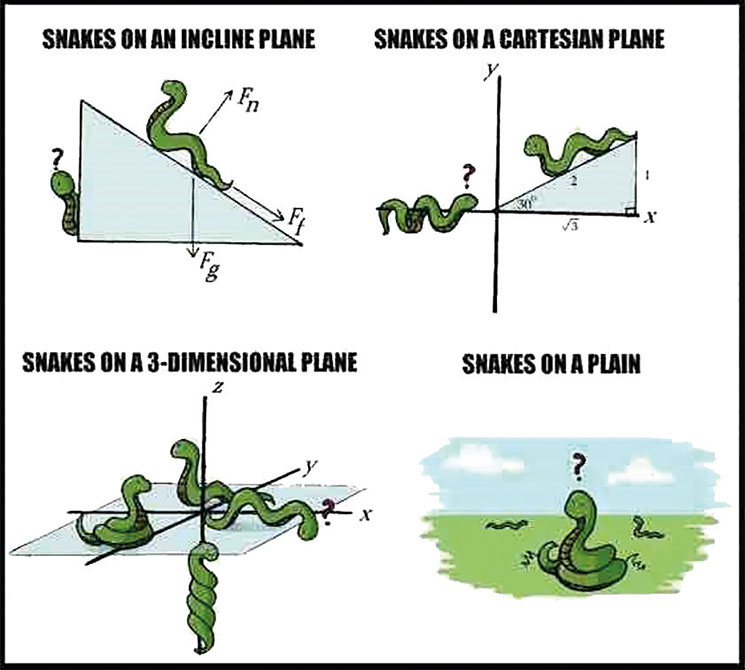
https://me.me/i/snakes-on-an-incline-plane-snakes-on-a-cartesian-plane-8682c85e0dc143d993b9304d68f734ce
Memes reflect the cultural concerns of the users
We can now draw the first conclusion of this study: during the process of memetic drift, memes are remixed, parodied, mashed up and altered to reflect the concerns of the culture in which the users engaging in memeiosis operate. When the rather innocuous story of Cheryl’s arsonist husband is turned into political aggression (as in the anti-Democratic and anti-republican variants of the meme), or when someone connects the completely extraneous idea of a meth lab to the suburban settings of Cheryl and Victor’s home, or the rapper snitching is connected to the arson, we see more about what the users are thinking about, than about the original meme. We could argue that the original meme is merely an excuse or a pretext to raise political, cultural, or otherwise newsworthy concerns. This is not an original claim, incidentally. For example, Zannettou et al. [Zannettou et al. 2018] state that “memes are often posted in response to world events, e.g., political memes peaked around the 2016 US Presidential Elections and racist memes spiked on Gab close to the Charlottesville incident in August 2017” (p. 16).
Memetic drift is not a new phenomenon. We know from etymology that word meanings may change radically over time: my favorite example is the English expression “make love” which in 18th century meant “flirt” and has shifted to mean “engage in intercourse.” Likewise we know that cultural themes (memes) may evolve significantly (for example, consider the evolution of the meme “witch” from the 17th century to modern feminist reappropriations or Wiccan ceremonies). What has changed is the rate of mutation, so to speak. Much like genes change by random mutations, memetic drift happens in multiple non-coordinated directions (they are not random, as they reflect the interest and concerns of the community, but they are not planned or coordinated). However, whereas in the past, a retelling of a witch story would require significant amounts of time and effort, the quasi-instantaneous nature of the internet distribution and the digital tools to manipulate the images and other mediatic support for the memes, have accelerated the rate of drift significantly.
Differences
We have examined the ways in which joke cycles and meme cycles are similar. It is a fair question to ask how memeiosis is different in the age of the internet. I think the primary differences can be summed up as follows.
Creation rate
Even though it is very hard to quantify the numbers of memes created both today and in the past, if we compare joke cycles to meme cycles, I believe that we can make a cogent argument for the claim that memeoisis is the fastest it has ever been in human history. The first argument in support of this is that the production of humor on the internet is faster due to the quasi-instantaneous diffusion of the cultural artifacts [Davison 2009: 122; Chiaro 2018; Jennings 2018]. The second argument, which is not in contrast to the previous, is that the internet is a multiplicative technology which has the effect of speeding up the process of memeiosis. As I suggested in [Attardo 2017b], there have been three major epochal changes in culture: the invention of writing, the invention of moveable type printing, and the internet. Essentially, each of these new technologies, at the time of their introduction, changed significantly the economy of disseminating ideas: writing allows the creation and preservations of a record of someone’s thoughts, thus allowing a much broader diffusion of ideas, since not only those few who could physically listen to, say, Socrates speaking have access to his ideas, but a much larger number of potential readers. Needless to say, not everyone had access to papyrus or vellum, cost being a significant aspect of it. The invention of moveable type reduces the cost of making multiple copies of a manuscript by several orders of magnitude (a backof-the-envelope calculation allows us to estimate that in the time it took for a copist to copy one manuscript, thousands could be printed). Finally, the internet reduces the cost of diffusion to essentially zero (there are other costs, such as that of producing the manuscript, but we will ignore them here).
It will come as no surprise then that the first recorded collections of jokes are found in Hellenistic times (e.g., the Philogelos), and that collections of facetiae (Renaissance jokes) were quite frequent in the post-Gutenberg era, and that the heydays of joke cycles were the “age” of jokelore, i. e., jokes and cartoons reproduced via photocopy machine and distributed by fax. The Xerox machine was introduced in 1959 and quickly came to dominate the world of copying. In 1964, the facsimile transmission over telephone wires was introduced, also by Xerox Corp. Both the copier and the fax machine allow for fast and cheap reproduction and diffusion of graphics, which explains the mixture of visuals and alphabetic text characteristic of jokelore (see [Dundes, Pagter 1975; 1987]). Obviously, it would be very difficult to reproduce the graphics that accompany many items of jokelore and so we see how the affordances of the medium influence the material produced.
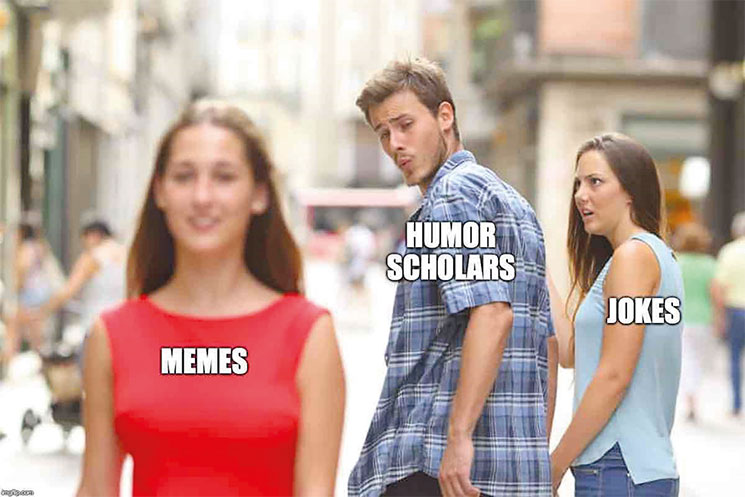
Thus by analogy, we can conclude that the speed of diffusion of memes has been made essentially instantaneous (a share on Facebook, Twitter, Whatsapp, or Instagram, is practically instantaneous). Likewise, using a meme generator allows a user to produce a new meme in seconds. It took me 50 seconds, on a relatively slow internet connection, to create the meme above (Figure 15). The platform I used, Imgflip.com, conveniently allows you to post your meme on various platforms or email it to anyone you want in seconds. Let me add, this was my second time ever creating a meme. With some practice, I could probably get the time down to 15 or 20 seconds. On speed and memeiosis, in a different perspective, see also Lewis [Lewis 2012].
Memes are formulaic
The formulaic nature of memes has been recognized early on, e.g., Davison [Davison 2009: 127] provides the following formula for the “advice Dog” meme
- Image of dog in center of rainbow.
- First line of advice.
- Second line of advice (usually a punch line).
The idea is sound, but the implementation is lackluster: “usually a punch line” is not specific enough for humor studies. Another attempt at providing a formula for memes is reported by Lewis [Lewis 2012].
KnowYourMeme.com (n.d.) reports that SoaP remixes follow a particular formula:
- Start with the title: Snakes on a Plane.
- Next, alter it while keeping the same flow, but changing the meaning. Example: Snakes love John Coltrane.
- Throw in a bad MS Paint drawing of a snake, an image of Samuel L. Jackson, and a Jackson-esque action movie catchphrase to tie it all together. Example: That’s some smooth jazz, motherfucker! [Lewis, 2012: 113].
The formula quoted by Lewis has been removed from the page, probably because it is self-evidently incapable to handle the multitude of variations of the meme. A much better approximation is “NP on a(n) NP” (https://knowyourmeme.com/memes/subcultures/snakes-on-a-plane).
Let us go back to the template I used to generate my meme; it functions as follows: the user is invited to add three pieces of text, that specify emblematically what the characters in the original image “stand for.” The information provided, in GTVH terms comes from the following Knowledge Resources:
Field 1 (red dress woman): Situation Knowledge Resource.
Field 2 (Boyfriend): Target Knowledge Resource.
Field 3 (scorned girlfriend): Situation Knowledge Resource.
The original image can be paraphrased as: The boyfriend of a young woman, turns around to admire another woman, while walking with his girlfriend. By doing so he shows that he is more interested in this new woman than in the one with whom he has presumably a steady relationship. This is a form of betrayal, for which the girlfriend is justly outraged. This seems to corresponds to Davison’s “ideal” of the meme.
At the Logical Mechanism level, the structure can be represented as X loses interest in Y because of a new object Z. This is a betrayal of Y and Y is righteously angry.
The introduction of new referents for the variables X, Y, and Z and the intertextual reference to the original image and other memes of the distracted boyfriend cycle complete the logical mechanism. The script opposition, in this example, is of course between ROMANTIC CHEATING and ACADEMIC FADS. In other examples, the first item will remain the same, but the other will change due to the material introduced in slots Y and Z.
Multimodality and image manipulation
The other difference is that jokes are texts produced entirely within a modality (linguistic) whereas memes are to a large extent multimodal. While there are no doubt memes that are entirely text-based, or that rely exclusively or primarily on text to convey information, the typical internet meme uses images and text, or in some cases just images. There exist animated memes and video memes that are video clips, often of “fails” (i. e., people falling, or performing spectacularly bad some activity). They often circulate in “compilations” that aggregate several of them, for example on Youtube. Other forms exist, for example, clips from TV shows, the famous “ice bucket challenge,” scenes from sitcoms, etc. Companies such as Funny or die, have been created to produce similar videos. One interesting format of video memes are “reaction” videos, which show people watching a video, usually not shown, and reacting to the content.
As we discussed in the previous section, the affordances of the medium and the availability of cheap and easy to use video-editing software and recoding equipment have enabled the possibility of these memes. It is now possible to shoot professionallooking video, edit it, and post it to a web site such as Youtube, on a cellular phone. Less than two decades ago, the same capability would have cost in over $10,000. Much like the selfie as a genre was made possible by the widespread availability of phones with two cameras (one facing outward and one facing inward), the capacity to do video and sound editing on a phone allows both the technical capacity to produce the video and speeds up the process. Along the same lines, anyone with internet access can upload a video to Youtube, Vimeo, or another video web-site and potentially achieve worldwide distribution which would have required massive investments in the age of celluloid movie on reels.
Hence we can reach the conclusion that, while joke cycles and meme cycles differ in significant ways, the differences are not structural, but rather they belong to the pragmatic domains of the means of production and distribution, which have radically changed and whose affordances enable forms and genres that would have been impractical or impossible without them. For example, reaction videos or Hitler in the bunker parodies [Hirsch 2019] are possible only when recording vast amounts of footage is essentially cost-free, and thus one can select a couple of minutes of funny reactions from hours of recoding, or when one has access, again essentially for free, to video-editing capabilities that would rival those of a professional video-maker.
Aside from these very real differences, meme cycles have not changed much from joke cycles.
Conclusions
In this paper we have analyzed the meme cycle Cheryl’s She Shed and shown that users project their concerns and interests on the original meme. We have also shown that meme cycles and joke cycles share significant similarities and more specifically that the tripartite division between jokes, intertextual jokes and meta jokes can be usefully applied to the meme cycles. Finally we have shown that the same distance metric used in the GTVH for jokes can be applied to humorous memes. We then briefly discussed the way in which meme cycles are different from joke cycles and found that speed of production and distribution are the most notable ones.
It should be obvious that much more work needs to be done. Among the possible areas of research is to quantify more precisely the notion of distance, for example using visual methods such as those in Zannettou et al. [Zannettou et al. 2018]. Another area pioneered by Shifman is to consider the spread of such memes as Cheryls’ She Shed to other non-culturally homogenous communities.
Abrahams, R. (1961). Ghastly commands: The cruel joke revisited. Midwest Folklore, 11 (4), 235–246.
Allen, D. W. (2003). Rtmark: Viral Activism and the Meaning of “Post-Identity”. The Journal of the Midwest Modern Language Association, 36 (1), 6–24.
Attardo, S. (1994). Linguistic Theories of Humor. Berlin: Mouton de Gruyter.
Attardo, S. (2001). Humorous texts. Berlin: Mouton De Gruyter.
Attardo, S. (2017a). The General Theory of Verbal Humor. In S. Attardo (Ed.), The Routledge Handbook of Language and Humor (pp. 126–142). New York: Routledge.
Attardo, S. (2017b). Change, mass availability and the decline of quality in academe. Mélanges Centre de Recherche et d’Applications Pedagogiques en Langues, 37, 101–105.
Attardo, S., Raskin, V. (1991). Script theory revis(it)ed: joke similarity and joke representation model. HUMOR: International Journal of Humor Research, 4 (3–4), 293–347.
Benitez Bribiesca, L. (2001). Memetics: a dangerous idea. Interciencia, 26 (1), 29–31.
Blackmore, S. (1999). The Meme Machine. Oxford: Oxford University Press.
Börzsei, L. K. (2013). Makes a Meme Instead. New Media Studies Magazine.
Boskin, J. (Ed.). (1997). The humor prism in 20th-century America. Wayne State University Press.
Buchel, B. (2012). Internet memes as means of communication. Unpublished PhD dissertation. Masaryk University.
Burgess, J. (2008). ‘All your chocolate rain are belong to us?’ Viral Video, YouTube and the dynamics of participatory culture. In G. Lovink, S. Niederer (Eds), Video vortex reader: Responses to YouTube (pp. 101–109). Amsterdam: Institute of Network Cultures.
Chiaro, D. (2018). The Language of Jokes in the Digital Age. New York: Routledge.
Davies, C. (1990). Ethnic humor around the world: A comparative analysis. Bloomington, IN: Indiana University Press.
Davison, P. (2009). The language of internet memes. In M. Mandiberg (Ed.), The Social Media Reader (pp. 120–134). New York: NYU Press.
Dawkins, R. (1976). The Selfish Gene. Oxford: Oxford University Press.
Dennett, D. (1991). Consciousness Explained. Boston: Little & Brown.
Dennett, D. (1995). Darwin’s Dangerous Idea. New York: Simon & Schuster.
Dundes, A. (1987). Cracking Jokes: Studies of Sick Humor Cycles and Stereotypes. Berkeley, CA: Ten Speed Press.
Dundes, A., Pagter, C. R. (1975). Work hard and you shall be rewarded: Urban folklore from the paperwork empire. Detroit, MI: Wayne State University Press.
Dundes, A., Pagter, C. R. (1987). When You’re up to Your Ass in Alligators: More Urban Folklore from the Paperwork Empire. Detroit, MI: Wayne State University Press.
Hay, J. (2001). The pragmatics of humor support. HUMOR: International Journal of Humor Research, 14 (1), 55–82.
Hempelmann, C. F. (2003). “99 nuns giggle, 1 nun gasps:” The not-all-that-Christian natural class of Christian jokes. Humor: International Journal of Humor Research, 16 (1), 1–32.
Hirsch, G. (2019). Hitler’s out of Dope: A cross-cultural examination of humorous memes. Journal of Pragmatics, 149, 25–39.
Jenkins, H., Ford, S., Green, J. (2013). Spreadable media: Creating value and meaning in a networked culture. New York: NYU press.
Jennings, K. (2018). Planet Funny. How Comedy Took Over Our Culture. New York: Scribner.
Knobel, M., Lankshear, C. (2008). Remix: The art and craft of endless hybridisation. Journal of Adolescent & Adult Literacy, 52 (1), 22–33.
Kuipers, G. (2005). “Where Was King Kong When We Needed Him?” Public Discourse, Digital Disaster Jokes, and the Functions of Laughter after 9/11. The Journal of American Culture, 28 (1), 70-84.
Laineste, L., Voolaid, P. (2016). Laughing across borders: Intertextuality of internet memes. The European Journal of Humour Research, 4 (4), 26–49.
Lasn, K. (1999). Culture Jam: How to Reverse America’s Suicidal Consumer Binge — And Why We Must. New York: Harper Collins.
Lewis, L. C. (2012). The participatory meme chronotope: Fixity of space/rapture of time. In B. Williams, A. A. Zenger (Eds), New media literacies and participatory popular culture across borders (pp. 117–132). New York: Routledge.
Matsubara, Y., Sakurai, Y., Prakash, B. A., Li, L., Faloutsos, C. (2012). Rise and fall patterns of information diffusion: model and implications. In Proceedings of the 18th ACM SIGKDD international conference on Knowledge discovery and data mining (pp. 6–14). Association for Computing Machinery.
Meier, M. R., Medjesky, C. A. (2018). The Office was asking for it: “that’s what she said” as a joke cycle that perpetuates rape culture. Communication and Critical/Cultural Studies, 15 (1), 2–17.
Mitzel, A. D. (2020). Ephemerality and Diaspora: the memes of production in Italian Americana. Unpublished PhD dissertation. University College London.
Raskin, V. (1985). Semantic Mechanisms of Humor. Dordrecht: D. Reidel.
Segev, E., Nissenbaum, A., Stolero, N., Shifman, L. (2017). Families and networks of internet memes: The relationship between cohesiveness, uniqueness, and quiddity concreteness. Journal of Computer-Mediated Communication, 20 (4), 417–433.
Shifman, L. (2014a). Memes in digital culture. MIT press.
Shifman, L. (2014b). The cultural logic of photo-based meme genres. Journal of Visual Culture, 13 (3), 340–358.
Shifman, L., Thelwall, M. (2009). Assessing global diffusion with Web memetics: The spread and evolution of a popular joke. Journal of the American society for information science and technology, 60 (12), 2567–2576.
Sutton-Smith, B. (1960). “Shut up and keep digging”: The cruel joke series. Midwest Folklore, 10 (1), 11–22.
Tsakona, V. (2020) Tracing the trajectories of contemporary online joking. Media Linguistics.
Walker, G. (1958). The way those joke cycles start. The New York Times Magazine, Oct. 26th, 32–39.
Zannettou, S., Caulfield, T., Blackburn, J., De Cristofaro, E., Sirivianos, M., Stringhini, G., Suarez-Tangil, G. (2018). On the origins of memes by means of fringe web communities. In Proceedings of the Internet Measurement Conference 2018 (pp. 188–202). ACM.
Статья поступила в редакцию 29 октября 2019 г.;
рекомендована в печать 17 февраля 2020 г.
© Санкт-Петербургский государственный университет, 2020
Received: October 29, 2019
Accepted: February 17, 2020
